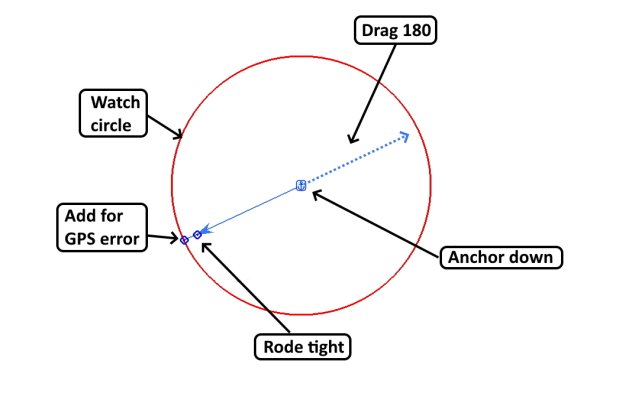markpj23
Senior Member
- Joined
- Mar 25, 2021
- Messages
- 201
- Vessel Name
- Black Horse
- Vessel Make
- Med Yachts 62
I thought I understood this, but a rather sleepless night at anchor has me rethinking my approach.
I usually take my anchor scope (always at least 5x the depth) and double it to find the swing circle. Simple diameter = 2r equation. Due to the GPS variance I'll usually add another 50% of scope and set the alarm. For example, with 50ft of chain at the water's edge I set 125ft as the swing circle alarm point.
Nope - way too many false alarms. I increased the circle to 145ft before I got any peace. Checking LOBs and watching the anchor chain a lot gave me confidence we were holding just fine. The wind did shift 270 degrees during the night, in two main shifts vice gradually. Each shift caused an alarm - I guess that's why they built a pilot berth near the helm eh?
I suppose it's possible that the anchor reset itself. We were in a sandy bottom area (anchor is an oversized Mantus, all chain rhode). It's also possible that my little hand-held GPS was not that precise. Or it's possible that my outlook on this problem is wrong.
Try to resist the urge to turn this into another which-anchor-is-best thread
So what method do you use to set your anchor watch?
I usually take my anchor scope (always at least 5x the depth) and double it to find the swing circle. Simple diameter = 2r equation. Due to the GPS variance I'll usually add another 50% of scope and set the alarm. For example, with 50ft of chain at the water's edge I set 125ft as the swing circle alarm point.
Nope - way too many false alarms. I increased the circle to 145ft before I got any peace. Checking LOBs and watching the anchor chain a lot gave me confidence we were holding just fine. The wind did shift 270 degrees during the night, in two main shifts vice gradually. Each shift caused an alarm - I guess that's why they built a pilot berth near the helm eh?
I suppose it's possible that the anchor reset itself. We were in a sandy bottom area (anchor is an oversized Mantus, all chain rhode). It's also possible that my little hand-held GPS was not that precise. Or it's possible that my outlook on this problem is wrong.
Try to resist the urge to turn this into another which-anchor-is-best thread

So what method do you use to set your anchor watch?


